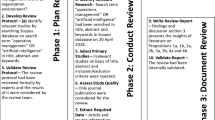Abstract
Next Generation Enterprises (NGEs) rely on automation, mobility, real-time business activity monitoring, agility, and self-service over widely distributed operations to conduct business. It is important to study and analyze such enterprises because they will drive the future industry and job markets. This paper gives a quick overview of NGEs and proposes a conceptual framework for analyzing the IT infrastructure needed to support the NGEs. A systematic discussion and analysis of key building blocks, their interrelationships, and main trends is presented with an emphasis on monitoring and split-second reaction times needed across widely distributed business units of such enterprises.
Similar content being viewed by others
References
Acharya R. EAI: A Business Perspective, eAI Journal, http://www.bijonline.com/PDF/Apr03Acharya.pdf, April 16, 2003.
Akiha N. Web Services at Work, Data Management Review, http://www.lifecycleplus.com.au/news_archive_april.htm, April 2003.
Arsanjani A. Developing and Integrating Enterprise Components and Services, Comm. of ACM 45(10);2002:31–34.
Askit M. (ed.), Software Architectures and Component Technology, Kluwer Series in Engineering and Computer Science, 2001.
Bennet K. Legacy Systems: Coping with Success, IEEE Software 1995:19–23.
Brodie ML. Stonebroker M, Migrating Legacy Systems, Morgan Kauffman, 1995.
Burbeck S. The evolution of Web Applications into service-oriented components with Web service, IBM White Paper, October 1, 2000, http://www-106.ibm.com/developerworks/Webservices/library/ws-tao/
Business Process Execution Language for Web Services, version 1.1, http://www.ibm.com/developerworks/library/ws-bpel/
Caccia R. Extreme Integration: Connecting Everything in a Dynamic World, eAI Journal, http://www.bijonline.com/Article.asp?ArticleID=535, 2002.
Charlesworth I. Jones T. The EAI and Web Services Report, eAI Journal, http://www.bijonline.com/PDF/Mar03CoverCharlesworth.pdf, march 2003.
Clemens P, Klein K. Evaluating Software Architectures, Addison Wesley, 2002.
Curbena F, et al. The Next Step in Web Services, CACM 46(10);2003.
Desai A. Adaptive Complex Enterprises, Comm. of ACM 2005:32–35.
Ramanathan J. Fractal Architecture for the Adaptive Complex Enterprise, Comm. of ACM 2005:53–57.
Davis M. et al., Using an ASP: What are the Risks and Benefits?, Gartner Research Note, http://www.gartner.com, 2000.
Dharwan C. Moble Computing—A Systems Integrator’s Hanbook. McGraw-Hill, 2000.
Drucker P. The Next Society, The Economist, Nov 1st 2001.
Ferreira I, Dutton N. Enterprise Application Integrator Market Forecast, Ovum Group Report, http://www.ovum.com,/May 17, 2003.
Friedman T. The World Is Flat, Farrar, Straus & Giroux, 2005.
Flurry G. An example of Web services applied to e-business, IBM White paper, January 1, 2001, http://www-106.ibm.com/developerworks/Webservices/library/ws-wsasp/
Garlan D, Shaw M. An Introduction to Software Architecture, in Advances in Software Engineering and Knowledge Engineering, New York, World Scientific, I;1993.
Gartner Group Symposium/Itxpo, Real-time Enterprises and Business Continuity Planning, http://www.gartner.com, 2000.
Gartner Group Report, Middleware Technologies, Gartner Report, http://www.gartner.com, 1999.
Goldenberg B, The CRM Evolution, CRM Magazine 2002.
Gelbmann T, System Management: Is Your Firm Prepared for e-Business? New Jersey Law Journal, 2000.
Ghettie I, Networks and Systems Management, Kluwer, 1997.
Goyal S, Worrest RW. Expert Systems in Network Maintenance and Management, International Communications Conference’86, Toronto, 1986:1225–1229.
Guizzo E. Closing in on the Perfect Code. IEEE Spectrum, 2004:36–42.
Herzum P, Sims O. Business Component Factory, John Wiley, 2000.
Heineman G, Councill W. Component-Based Software Engineering, Wiley, 2001.
Hill J, et al., The Platforms Enabling Wireless Sensor Networks, CACM, 2004:39–46.
Jones J. Real Time’s Trickle-Down Effect, Infoworld, http://reviews.infoworld.com/infoworld/article/02/01/17/020121ferealtime_1.html, 17:2002.
Jovanov R. et al., Patient Monitoring Using Personal Area Network of Wireless Intelligent Sensors, Biomedical Sciences Instrumentation 3737:373–8;2001.
Kalakotta R, Robinson P. M-Business. McGraw Hill, 2002.
Kalakota R. Mobile Enterprise Applications. e-Business Strategy White Paper, Jan. 2004.
Laudon and Laudon, Management Information Systems, 8th edn., Prentice Hall, 2004.
Liberti J, Rappaport T. Smart Antennas for Wireless Communications, Prentice Hall, 1999.
Lindorff D. GE’s Drive to Real-Time Measurement, CIO Magazine 11;2002.
Linthicum L. Enterprise Application Integration, Addison Wesley, 1999.
Linthicum L. B2B Application Integration: e-Business-Enable Your Enterperise, Addison Wesley, 2001.
Little M. Transactions and Web Services, CACM 46(10);2003.
Margulius, Dawn of the real-time enterprise, InfoWorld, 17;2002.
Mello A. Breathing New Life into UDDI, Zdnet Report, http://techupdate.zdnet.com/techupdate/stories/main/0,14179,2872349,00.html, 26, 2002.
Rao N. Extreme Integration: Connecting Applications in a Dynamic World, eAI Journal, http://www.bijonline.com/Article.asp?ArticleID=538, 2002.
Ruh W, Maginnis F, Brown W. Enterprise Application Integration, John Wiley, 2002.
Schmidt D. Adaptive and Reflective Middleware Systems, Presentation, DARPA/ITO, 2001.
Schick K. The Key to Client/Server—Unlocking the Power Legacy Systems, Gartner Group Conference, 22–24;1995.
Security Assertion Markup Language (SAML), http://www.oasis-open.org/SAML
Semantic Web, http://www.w3c.org/2001/sw/
Smith H, Fingar P. Business Process Management: The Third Wave, Megham-Kiffer Press, 2003.
Stallings W. Wireless Communications and Networks, Prentice Hall, 2nd edn., 2005.
Stal M. Web Services: Beyond Component-based Computing, Comm. of ACM 45(10);2002.
Szewczyk R, et al. Habitat Monitoring with Sensor Networks, CACM;2004:34–38.
Umar A. e-Business and Distributed Systems Handbook: Architecture Module, NGE Solutions, Updated August 2004a.
Umar A. e-Business and Distributed Systems Handbook: Integration Module, NGE Solutions, Updated August 2004b.
Umar A. e-Business and Distributed Systems Handbook: Middleware Module, NGE Solutions, Updated August 2004c.
Umar A. Mobile Computing and Wireless Communications, NGE Solutions, August 2004d.
Umar A. Information Security and Auditing Age in the Digital Age, NGE Solutions, May 2004e.
Umar A. eGuru—A Pattern-based Decision Support Workbench for e-Business, Telcordia Technologies White paper, 2001.
Umar A. e-Business and Distributed Systems Handbook: Platforms Module, NGE Solutions, Updated 2004f.
Web Services Coordination, version 1.0, http://www.ibm.com/developer-works/library/ws-coor/.
Web Services Transactions, version 1.0, http://www.ibm.com/developer-works/library/ws-transpec/
Weber F. Integration Theory, CRC Press, 1997.
White C. Determining Enterprise Portal ROI, Data Management Review, April 2003.
Whyte W, Whyte B. Enabling e-Business—Integrating Technologies Architectures & Applications, John Wiley & Sons, 2001.
Author information
Authors and Affiliations
Corresponding author
Rights and permissions
About this article
Cite this article
Umar, A. IT Infrastructure to Enable Next Generation Enterprises. Inf Syst Front 7, 217–256 (2005). https://doi.org/10.1007/s10796-005-2768-1
Issue Date:
DOI: https://doi.org/10.1007/s10796-005-2768-1




